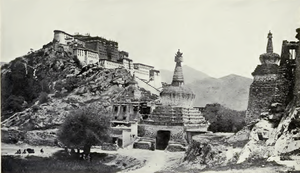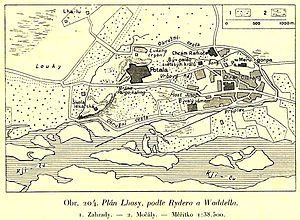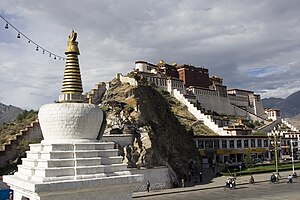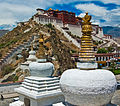Pargo Kaling



The Pargo Kaling (Tibetan: བར་སྒོ་བཀག་གླིང, Wylie: bar sgo bkag gling) was a large chorten straddling across the road leading from Drepung between the Potala's Red Hill (Marpori) and the Iron Hill (Chagpori) at Lhasa, Tibet, and containing a through-passage or archway for people and animals. It formed the "Western Gate" of the city and led into the village of Shol. It was destroyed in 1967,[1] but the Lhasa authorities had it rebuilt in 1995.[2][3][4]
One of three chortens

As shown by photographs taken in 1904 and 1938, the Pargo Kaling chorten was one of three chortens: a second one was perched on the low ridge of Marpori and a third one stood on the low ridge of Chagpori.[1] From the top of the middle chorten, wires furnished with small bells were stretched to the top of the two smaller chortens.[5]

Names
The Tibetan name of the Western Gate has several variants besides Pargo Kaling: Pawogaling (Peter Aufschnaiter[6]), Drakgo Kaling (André Alexander[7]), Barkokani or Bakokani (G. Ts. Tsybikoff), and Bar chorten (also G. Ts. Tsybikoff).[8]
The oldest known representation of the Pargo Kaling Gate is found on a map of the city of Lhasa drawn by Nikita Bichurin in the first half of the 19th century. In the left lower corner, the larger centre chorten with its through-passage can be seen in between the two smaller side chortens.
Representations
The Western Gate was the scene of the entrance of the British Army's invasion force to Lhasa on August 4, 1904.[9] Preceded by the Chinese Imperial commissioner's escort.,[10] Younghusband's soldiers entered the city through the arch in the Pargo Kaling chorten[11]
The Pargo Kaling chorten was also depicted in a scene of the 1997 movie Seven Years in Tibet, which was the adaptation of the book of that title by Heinrich Harrer. The cover art of the original motion picture soundtrack shows actor Brad Pitt and the young 14th Dalai Lama with the chorten in the background.
The English version of Peter Aufschnaiter's memoirs Eight Years in Tibet, published in 2002, includes a photo of the chorten with the caption "Pawogaling, the Western Stupa below the Potala."[12]
A photo of the famous landmark is on the cover of Kamal Ratna Tuladhar's book, Caravan to Lhasa, published in 2004, about the story of Nepalese Newar traders in Tibet from the 1920s to the 1960s.[13]
A song to the Western Gate
In the 1980s, the lost Western Gate inspired a song sung by Tibetan singer Dadon. The lyrics of the first verse and the chorus go like this:
In front of the Potala Palace / There were three beloved stupas / Whenever the wind stirred the chimes / What resounding music there was / How melodious it sounded.
Aah stupa Drago Kaling / Aah, in my mind I suddenly remember / In the depth of my heart I suddenly remember you.

References
- ^ a b André Alexander, The Traditional Lhasa House: Typology of an Endangered Species, LIT Verlag Münster, 2013, 409 pages, p. 54: "In 1948, [...] There were no more city walls, but two gates. One was the Drakgo-kaling, a gate consisting of three stupa monuments located between the Potala Palace and Chakpori Hill (demolished in 1967 and rebuilt in 1995). The other was located at the western edge of the central urban cluster, from where one had to cross a bridge and pass by the important Western Rigsum Gonpo temple in order to reach the Potala."
- ^ Clare Harris, The Museum of the Roof of the World: Art, Politics, and the Representation of Tibet, University of Chicago Press, 2012, 314 p., p. 199: "The Lhasa authorities have made some attempt to reinstate it [the view] by rebuilding the three stupas of the Pargo Kaling (Western Gate) that was destroyed in the 1960s."
- ^ Lhasa map: 1980: "In 1980, [...] The old city gate, in the form of a Buddhist stupa, has disappeared."
- ^ Lhasa Map: 1998: "A replica of the old city gate has been built at the original site."
- ^ Lhasa, Bar Chorten, the Western Gate or Pargo Kaling gateway, Tibet - from the collection of the American Geographical Society Library, University of Wisconsin at Milwaukee.
- ^ Eight Years in Tibet, Bangkok, Orchid Press, 2002, p. 71.
- ^ The Traditional Lhasa House: Typology of an Endangered Species, LIT Verlag Münster, 2013, 409 pages, p. 54.
- ^ Lhasa, Bar Chorten, the Western Gate or Pargo Kaling gateway, Tibet - from the collection of the American Geographical Society Library, University of Wisconsin at Milwaukee.
- ^ Younghusband, Francis. "India and Tibet; a history of the relations which have subsisted between the two countries from the time of Warren Hastings to 1910; with a particular account of the mission to Lhasa of 1904". archive.org. Archived from the original on 6 December 2007. Retrieved 2017-08-13.
- ^ Edmund Candler, The Unveiling of Lhasa, London, Edward Arnold, 1905, p. 250: "In front of us marched and rode the Amban's escort — his bodyguard, dressed in short loose coats of French gray, embroidered in black, with various emblems; pikemen clad in bright red with black embroidery and black pugarees; soldiers with pikes and scythes and three-pronged spears, on all of which hung red banners with devices embroidered in black."
- ^ Edmund Candler, op. cit., p. 250: "An epoch in the world's history was marked to-day when Colonel Younghusband entered the city to return the visit of the Chinese Amban. He was accompanied by all the members of the mission, the war correspondents, and an escort of two companies of the Royal Fusiliers and the 2nd Mounted Infantry."
- ^ Peter Aufschaiter, Eight Years in Tibet, Orchid Press, 2002: "Pawogaling, the Eastern Stupa below the Potala."
- ^ A Journal of Newar Studies, 2004/05, page 11.
Gallery
- The centre chorten seen from Chagpori Hill (2015).
- The three chortens seen from Chagpori Hill (2009).
- The centre chorten and the Chagpori Hill chorten (2011).
- The centre chorten and Chagpori hill chorten seen from Marpori Hill (2013).




